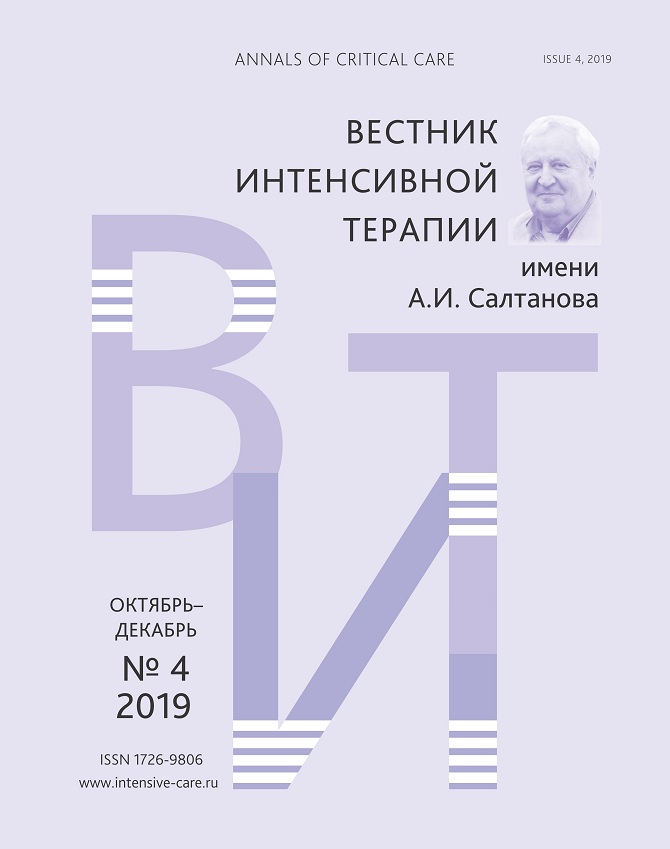Аннотация
Актуальность. Изменения гормонального статуса являются основными факторами реализации всех механизмов компенсации и защиты от дистресса, что особенно актуально для новорожденных в критическом состоянии.
Цель исследования. Изучить особенности гормонального статуса у новорожденных с врожденными пороками развития, нуждающихся в хирургическом вмешательстве и интенсивной терапии.
Материалы и методы. Обследовано 23 новорожденных с врожденными пороками развития, среди которых было 10 мальчиков и 13 девочек. Срок гестации составил 39,3 (38–40) недели. Среди врожденных пороков развития преобладали правосторонняя ложная диафрагмальная грыжа (25 %), атрезия пищевода с трахеопищеводным свищом (20 %), синдром Ледда (10 %) и омфалоцеле (15 %). Также были выявлены кистозное удвоение слепой кишки (5 %), болезнь Гиршпрунга (5 %), киста яичника (15 %) и лимфангиома забрюшинного пространства (5 %). Состояние детей при рождении было более тяжелым, о чем свидетельствует низкая оценка по шкале Апгар, которая на первой минуте составила 7,5 (6–8) балла, а на пятой — 8,0 (7–9).
Результаты исследования. Выявлено, что для детей с врожденными пороками развития характерны более высокие показатели концентрации кортизона, кортизола, альдостерона и более низкие 17-гидроксипрогестерона, 17-гидроксипрегненолона, ДГЭА и прогестерона, что явилось статистически значимым (р < 0,05). Концентрация кортизола и альдостерона была значительно выше на первом этапе исследования, что, вероятнее всего, обусловлено наличием стресса и массивной инфузионной терапией (р = 0,001). Установлено, что при поступлении в отделение реанимации и интенсивной терапии у пациентов отмечались достаточно высокие концентрации всех стероидных гормонов, причем концентрация кортизола и кортизона достигла максимума на третьем этапе исследования.
Заключение. У детей с врожденными пороками развития, подвергшихся оперативному лечению и интенсивной терапии, отмечается увеличение концентрации кортизола и кортизона с одновременным снижением уровня их предшественников, что является маркером стресса, обусловленного основным заболеванием и лечебными воздействиями.
Библиографические ссылки
- Шабалов Н.П. Неонатология. Учебное пособие в двух томах. М.: ГЭОТАР-Медиа, 2019. [Shabalov N.P. Neonatologiya (Neonatology) Uchebnoe posobie v dvuh tomah. M.: GEOTAR-Media, 2019. (In Russ)]
- Шабалов Н.П. Детские болезни. Учебник для вузов. СПб.: Питер, 2019.[Shabalov N.P. Detskie bolezni (Children disease) Uchebnik dlya VUZov. SPb.: Piter, 2019. (In Russ)]
- Селье Г. Стресс без дистресса. М.: Прогресс, 1979. [Sele G. Stress bez distressa (Stress without Distress). M.: Progress, 1979. (In Russ)]
- Hallman M. The story of antenatal steroid therapy before preterm birth. Neonatology. 2015; 107(4): 352–357. DOI: 10.1159/000381130.
- Dasgupta S., Jain S.K., Aly A.M. Neonatal Hypotension, the Role of Hydrocortisone and Other Pharmacological Agents in its Management. J Pediatr Child Care. 2016; 2(1): 08.
- Anand K.J., Brown M.J., Causon R.C., et al. Can the human neonate mount an endocrine and metabolic response to surgery? J Pediatr Surg. 1985; 20(1): 41–48.
- Crawford J.H., Hull M.S., Borasino S., et al. Adrenal insufficiency in neonates after cardiac surgery with cardiopulmonary bypass. Paediatr Anaesth. 2017; 27(1): 77–84. DOI: 10.1111/pan.13013
- Abdel Mohsen A.H., Taha G., Kamel B.A., Maksood M.A. Evaluation of aldosterone excretion in very low birth weight infants. Saudi J Kidney Dis Transpl. 2016; 27(4): 726–732. DOI: 10.4103/1319-2442.185234
- Talge N.M., Neal C., Glover V. Antenatal maternal stress and long-term effects on child neurodevelopment: how and why? Journal of Child Psychology and Psychiatry. 2007; 48(3–4): 245–261. DOI: JCPP1714[pii]10.1111/j.1469–7610.2006.01714.x
- Mörelius E., He H.G., Shorey S. Salivary cortisol reactivity in preterm infants in neonatal intensive care: an integrative review. Int J Environ Res Public Health. 2016; 13(3). pii: E337. DOI: 10.3390/ijerph13030337
- Hillman N.H., Kallapur S.G., Jobe A.H. Physiology of transition from intrauterine to extrauterine life. Clin Perinatol. 2012 Dec;39(4):769–783. DOI: 10.1016/j.clp.2012.09.009
- Albrecht E.D., Pepe G.J. Placental steroid hormone biosynthesis in primate pregnancy. Endocr Rev. 1990; 11(1): 124–150.


